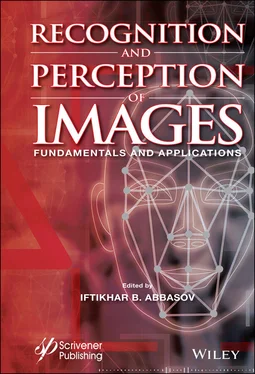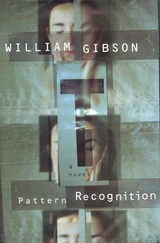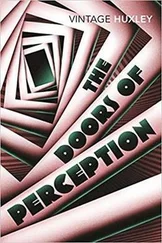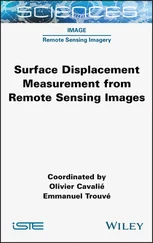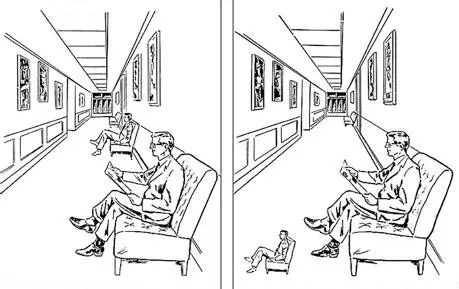
Figure 1.5.2 Constancy perception of size.
Constancy of Perception of the Form
The shape of the object can also be perceived stably, regardless of the angle of view. This feature of the visual system is called the constancy of perception of the form. Familiar to us doors are perceived as rectangular shapes, despite the angle at which we look at them. However, their projection on the retina has a rectangular shape only if they are directly in front of the observer.
1.5.2 The Development of the Process of Perception
To analyze the perceptual abilities of a person, some studies of abilities in infants can be noted. At the age of one month, babies cannot distinguish small details; their vision can only be distinguished by relatively large objects. Visual acuity is weak, facial expressions are difficult to distinguish, they see mostly the external contours of the face. Infants find some forms more interesting than others; they are more inclined to look at forms similar to human faces. By three months, the sharpness improves; the baby can already decipher facial expressions, and he has much more social reactions. He recognizes something in the face of the mother; when viewing he prefers to look at the photo of the mother, and not at the photo of an unfamiliar woman.
The perception of depth begins to appear at about three months of age, but is finally formed only by six months. At the age of four months, the infant begins to reach for the nearest of the two objects, determining which one is located closer to it, thanks to the binocular disparity. Constancy of perception also begins to develop from the first months of life.
1.5.3 Perception after Surgery Insight
From medical practice it is known that a person born blind, after an operation to restore vision in adulthood, faces many problems due to the lack of spatial impressions about the outside world. The mature people were unable to distinguish even simple objects or forms [Gregory, 1970]. After a long workout, they learned to recognize the simplest of the visible objects. But many have not been able to learn this, so they returned to the previous life of a blind person. This process was accompanied by strong emotional experiences. However, active and intellectually developed people, on the contrary, after the epiphany, were fairly well adapted.
Most patients had some repetitive processes:
– at first they see an objectively unorganized visual world, since there are a lot of unknown objects;
– they highlight the shape and background;
– the majority of patients are able to fix their eyes and follow moving objects;
– they have no objectivity of perception, they cannot determine the nature of the differences between objects;
– they have the ability to assess the spatial distance of objects.
Vision is restored more quickly in people who are blind after birth than in those who are blind. An interesting observation of a 52-year-old patient who underwent an insight operation is given in [Gregory, 1970]. At first, he did not see anything except a vague outline, but after a few days he could already walk through the hospital, find out the time by the wall clock, and watch the movement of cars through the window. In the zoo, he could correctly name most animals. Identifying objects, he often used his tactile experience. He had a specific perception of distance; for example, he thought that he would be able to touch the ground with his feet, being at the window at a height of 12 meters.
Sitting in the restaurant, he took the crescent moon for the reflection of a piece of cake in the mirror. He accurately estimated the distance and size of objects if he knew them well by touch. But he never learned to read with his eyes, although he immediately and without much difficulty began to distinguish between capital letters and numbers. He studied these letters at a school for the blind, and he did not perceive lower case letters. Therefore, it can be noted that he used his past tactile experience very effectively, which often limited the development of his visual perception.
In the museum, he was shown a machine placed under a glass cap, and he could not recognize it, although he dreamed of seeing it. When he was to take off the cap, and he could feel it, he said: “Now that I felt it, I see it.” In general, he perceived the world as dark and vague, which greatly upset him. After the onset of depression, he ceased to live an active life and died three years later. As noted, in such cases, the development of depression is quite characteristic. The image of the world around him, based on tactile sensations, was not able to accommodate a huge mass of constantly incoming new sensory information. Perhaps this led to the development of information stress, to the destruction of the established picture of the world, and then to a prolonged depression.
Studies on the role of congenital or acquired in the process of perception were performed on animals. A newborn animal is reared for some time in the conditions of sensory isolation, in darkness or in the absence of structured visual stimulation, and then its perceptual abilities are evaluated. It was found that in small young animals raised in the dark shortly after birth there is a perception of depth. They are usually observed underdevelopment or degeneration of cortical neurons, which indicates a violation of the analyzer system. As a result, it was noted that there are some innate mechanisms of visual perception in various species of animals.
The work of [Chen et al., 2019] considers the problem of development of the portable image recognition system for people with defective vision. These people face questions relating to the recognition and identification of visual information every day. In this case the portable intelligent image recognition system based on the technology of cloud and local data processing is offered. The system is more economical as it uses the highly efficient algorithms of the cloud server and captures the objects constantly scanning the incoming video. The device was tested under real-life conditions by people with defective vision in the way that facilitates them to recognize faces and identify the necessary people.
1.5.4 Illusion of the Moon
The illusion of the moon is manifested in the fact that when it is near the horizon, it seems to us that it is much larger than at its zenith, although its retinal images in both cases are unchanged in size ( Figure 1.5.3). The angular size of the projection of the moon (also the sun) on the retina is about 0.5°.
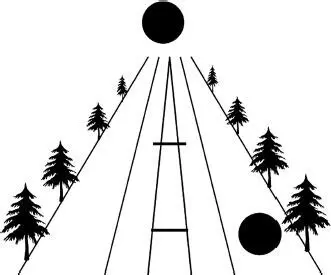
Figure 1.5.3 Illusion of the Moon.
The illusion of the moon caused great interest from ancient times, and many scientists tried to explain it [Abbasov, 2016].
According to the remoteness hypothesis, any object separated from the observer by a filled space seems to be more distant than an object distant at the same distance against the background of empty space. The perceived distance to the horizon is estimated to be greater than the distance to the zenith. The images of the moon on the retina are the same in both cases, but when the moon is on the horizon, it seems more distant to the observer.
In accordance with the hypothesis of relative size, the perceived size of an object depends not only on the size of its retinal image, but also on the size of nearby objects. The smaller these objects, the larger its apparent size. Above the horizon, the moon is perceived against the background of the surrounding landscape; at the zenith we perceive it against the backdrop of a visually free sky, a sign of remoteness “triggers the mechanism” of the constant perception of magnitude.
Читать дальше
